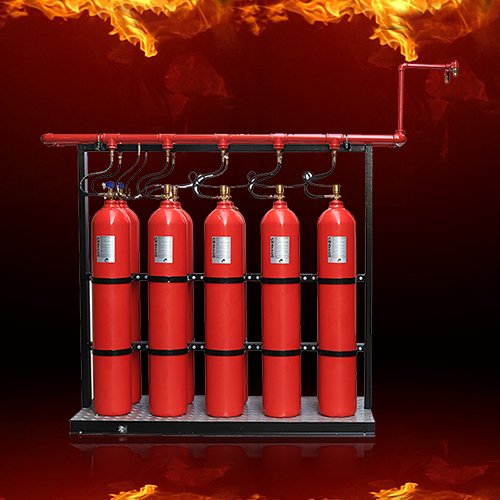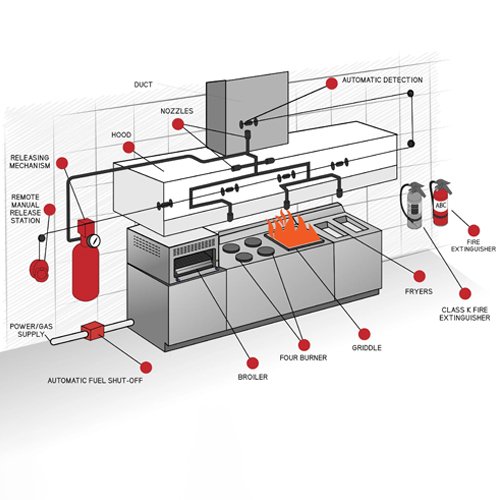-
Fire Extinguisher
- Multipurpose Dry Powder Type(stored Pressure)
- Water Type Fire Extinguishers (Stored Pressure)
- Dry Chemical Powder Type Fire Extinguishers(stored Pressure)
- M/foam (Afff) Type Fire Extinguishers (Stored Pressure)
- Dry Chemical Powder (Gas Cartridge) Type Fire Extinguishers
- W/co2 Type Fire Extinguisher (Gas Cartridge)
-
Security System
-
Fire Sprinkler
-
Alarm Solutions

FIRE SUPPRESSION SYSTEMS
Fire Suppression System Avoids damage and loss than the fire itself.
A fire suppression system is a managed collection of parts, built to extinguish fires with the help of the application of a particular substance. Most usually, fire suppression system has built-in elements that identify fires at the initial stages through heat, smoke, and other alert signals. By using water only, you can’t extinguish every fire. We want to tell you that water often causes more damage than fire does itself. This is the main reason to regulate the fire extinguishing tool during a fire accident. Thus, it becomes a critical part of the fire-fighting system design.
DGS has designed an unique hazard suppression systems for over 15 years. We have the most suitable solutions for guarding specific resources such as artwork, data storage rooms, retail cooking operations, and ignitable industrial hazards to ensure zero downtime to your business process and zero damage to your property or assets.
WHERE WE CAN USE SUPPRESSION SYSTEM

CLEAN AGENT
SUPPRESSION
Clean agents are an essential part of best fire suppression systems and considered safe for humans. They do not have a color, odor, they are electrically non-conductive also. They never leave any residue. They also hinder chemical chain of fire, stimulates suppression, and absorbs heat without destroying tender equipment, automatics, and electronics.
They guard the high-value assets such as data centers, priceless artifacts in a museum. We have waterless and environment-friendly clean agents.
DGS also designs and installs the best clean agent fire suppression systems.
According to the National Fire Protection Association (NFPA), a clean agency is an electrically non-conducting, volatile, or gaseous fire extinguishant that does not leave a residue upon evaporation.
A clean agent fire suppression system uses either a chemical or fixed gas to suppress a fire at inception stage before it can grow and is extremely effective in extinguishing Class A, B, and C fires.

Carbon Dioxide suppression system
Carbon dioxide (CO2) is an odorless, colorless, inert gas that helps to extinguish the fire by decreasing the oxygen that elevates fire in or around the fire hazard. We design to engulf a space for every specific fire hazard.
CO2 is not advised to ordinarily occupied spaces, except the cases when other modes of fire protection are not useful or sufficient. This inert gas needs no cleanup that helps to reduce the cost and downtime.
The system of CO2 is appropriate to a wide range of flammable and combustible substances. It is best for class A, B, and C exposures.
It covers typical hazards such as printing presses, vaults, open pits, ovens, engine rooms, coating machines, hoods and ducts, generators, and flammable liquid storage areas.
While CO2 fire suppression systems are highly useful at suppressing fires, CO2 agent also poses a health risk when compared to the other agencies.

WET CHEMICAL KITCHEN SYSTEMS
Nowadays, high-temperature cooking devices and vegetable-based cooking oils have become a big fire protection challenge. A restaurant fire suppression system is a significant method to assure that your commercial business is operating safely.
Commercial kitchen fire suppression systems are designed specially to manage the difficulties of retail cooking conditions.
Wet chemical agents help in reducing flames quickly and clean up easily with significantly less downtime than earlier comparable dry chemical systems.
The Wet Chemical Extinguishing vendor is a potassium carbonate-based solution that is discharged as fine droplets into a protected place.
The primary extinguishing activity is by cooling caused by the heat of vaporization. The fine spray release prevents the damaging splash of hot lubricant or thermal shock damage to cooking devices.
The Installation of fire fighting equipment in crowded facilities needs extensive expertise in the scheduling and performance of this nature of work. Our experience in the installation of hotel or restaurant fire fighting systems guarantees a minimum of agitation. Pipework for Wet Chemical systems may be black, chrome-plated or stainless steel to accommodate particular specifications of the application.
The system operates at a nominal pressure of 12 bar (175p.s.i.) providing a fine spray discharge lasting for a nominal 45 seconds. The unique nature of the Wet Chemical Extinguishing Agent eliminates many of the piping limitations commonly associated with dry chemical systems.
Wet chemical agents unlike dry powder are quickly cleaned up following a discharge resulting in a shorter downtime of the cooking range.
Wet chemical systems utilize storage containers in a range of sizes to accommodate the individual specifications of the fire accident.
The Wet Chemical system can be regulated manually or automatically by utilizing electrical detection equipment or mechanical fusible link designs.
Types of clean agent fire suppression systems
The most popular kinds of clean agent systems use chemical agents like
FM-200™, also commonly known as HFC-227ea, is a clean agent fire suppressant for Class A, B, and C fires and meets NFPA Standard 2001 Clean Agent Fire Extinguishing Systems. Clean agents are fast and effective in suppressing fires, are safe in occupied spaces, and do not leave a residue.
3M™ Novec™ 1230 is one of the leading clean agents used for fire suppression. Clean agent fire suppression systems can put out fires safely without damaging electronic equipment or machinery.
Inert gas suppression systems use argon and nitrogen gases and their mixtures as an extinguishing agent and are based in the principle of reducing the oxygen concentration inside the protected hazard.
DRY CHEMICAL INDUSTRIAL SYSTEMS
Where sprinklers and water are not favored, it is advised to install dry chemical suppression (IND) systems. They are specially designed to fit the requirements of severe industrial accidents majorly seen in manufacturing spaces.
Dry chemical systems are one of the least expensive fire suppression systems to install and maintain. Dry Chemical Fire Suppression Systems are specially prepared for unique demands of industrial, construction, and mining industries. It is also helpful for large, specialty automobiles. These systems use either Class ABC or Class BC dry chemicals to suppress fire.
Under these circumstances, a dry chemical fire detection system is suggested in order to help minimize repairs and replacement, reduce downtime & support to prevent operator injury. With dry chemical suppression systems, a fire in process tools can be rapidly detected, extinguished and production continued.

IND systems have two different dry chemical agents namely ABC powder and BC powder.
ABC is a multipurpose agent and is effectively used to tackle the Class A hazards (wood, paper, and other ordinary combustibles).
BC is most effective for Class B flammable liquid fires and Class C electrical fires.
Benefits
- Simple to design
- Reliable and secure fire protection
- Adjustable installation parameters
Our dry chemical systems help to match the growing demand for large capacity systems for the protection of ships carrying LNG/LPG and certain chemicals or agents in bulk.
The DGS Dry Chemical System is the most suitable choice for the protection of any industrial process or machinery where hazardous liquids or hazardous materials are included.
MICRO-ENVIRONMENT SYSTEMS
Most of the time, the small or congested spaces are the most difficult to protect from fire accidents. But DGS can help to reduce the most critical congested space fire risk also. Damia Global Services offers micro-environment suppression systems where electrical equipment and mission-critical processes remain. They are fully self-contained, require no electrical power, and are easy to install and maintain. They are just like an automatic fire extinguisher.
Fires happening in machines running oil-based coolant can cause significant damage in seconds and potentially cause extensive damage by spreading through your entire building. Even in the presence of operators, appliances have been completely destroyed. A Fire trace automatic fire suppression system can be installed on a device to support much of this danger.

This kind of fire suppression system can work in several microenvironments, including:
- Electrical control panels
- Computer/data storage cabinets
- Flammable chemicals storage cabinets
- Mass transit and specialty vehicles
- Vending machines
- Book, bank, and video depositories.
Running oil-based coolant in machines can cause significant damage in moments and possibly cause huge losses by spreading throughout your whole facility. Even in the appearance of engineers, machines get destroyed completely.
Damia Global Services Pvt. Ltd, an automatic fire suppression system can be installed on a machine to mitigate enough of the fire danger. We bring safe CNC machine fire protection to facilities and other microenvironments, assuring that fires will be immediately identified and suppressed, frequently before destruction is made to the machine.
Call us at +91-7009252789 or contact us online to learn more about Damia Global Micro Environment Fire Suppression systems.
You can schedule installation of a micro environment system today.